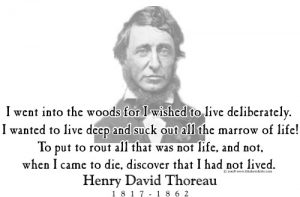
I urge anyone who has felt challenged by the emotional dissonance in the world to spend a few minutes time with the story of the passing of Craig Sager, veteran sports journalist. He was roundly respected and loved in a world of massive egos and short attention spans. Although his attire was flashy, his demeanor was anything but. He was, by all accounts, a mensch, or a fine man of high integrity and abiding humanity. Of the many heartfelt tributes to the man, I think Duane Wade’s moved me the most.

Above you read the a Henry David Thorough quote about “sucking the marrow out of life” and Sager’s double entendre shown here alludes to the fact that he underwent three bone marrow transplant during his treatment for leukemia.
With regard to stem cells and bone marrow transplants, I have a lot yet to understand; but then again, so does everyone else. The way in which stem cells coordinate with each other is more than mere signaling. They cooperate like social insects. Here’s what we do know:
- ) Mesenchymal stem cells in the bone marrow are the master copies of stem cells that carry your genetic endowment.
- ) When immortal blood producing stem cells lost certain regulatory genes, they can undergo uncontrolled growth and produce leukemia.
- ) Adding back a missing gene (as in the case of this condition “cured” by gene therapy) is a cure that lasts years, implying that the life of stem cells in bone marrow is very long (by virtue of telomerase activation)
What is the ideal way to prevent illness and disease? It involves three principles: intact data (DNA) and appropriate programming (epigenetics) of our bone marrow mesenchymal stem cells- (symbolized by Brahma, the creator), preservation of stem cells via telomerase – (symbolized by Vishnu, the preserver), and efficient destruction, usually by the cell itself but also by the immune system- (symbolized by Siva, the destroyer. See this blog for more on this analogy.)
Throughout our lives, we are replacing more specific regional stem cells from the less differentiated bone marrow mesenchymal stem cells. By the time you are older, there has been genetic “drift” and the accumulation of errors making you an effective chimera of your aboriginal genetic self. No one truly knows the distribution of genetic mosaicism that exists but we can presuppose that the variation increases until late in life, when it again drops off due to simple depletion of available master copies.
I attended a lecture at the A4M anti-aging conference in which the speaker said one of the oldest women in the world had only two mesenchymal stem cells left when she passed away. Intuition and science tells us that depletion of available stem cells would be a logical explanation for aging and disease because it explains both the phenotypic/genotypic degradation of all our cells and the loss of the adaptive immune system as well as the repository for replacement cells throughout the body (not the least of which are the stem cells creating blood elements that, when cancerous, give us leukemia.
If I had a wish list for curing aging and disease, here is what I would ask for:
- ) Accurate sequencing of single cell genomes – so we can assess the current genetic integrity.
- ) Accurate description of epigenetic states and RNA – so we can understand gene expression.
- ) Room temperature suspended animation of stem cells (as if frozen in amber) without metabolic or informatic degradation – so we can utilize them without damage from freezing to the organelles).
- ) Amber-frozen, archival copes of stem cells and their genetic/epigenetic states from embryonic stage, birth, and every year until age 25. So we can learn about splicing, transposition, deletion and duplication. We can also utilize earlier, fresher versions of our genome to replenish current stem cell niches.
- ) Safe and effective ability to edit DNA at the single base pair, gene sequence, and chromosomal arm level. This is for editing inborn errors, not trying to fix broken stem cells.
- ) Legal autologous use of “best copy” stem cells from storage.
- ) A precise cookbook stepwise way to induce all types of stem cells from the less differentiated mesenchymal stem cell master.
- ) A way to trigger apoptosis in damaged cells that may have lost some of their ability to do so. This is because much of aging and disease is paradoxically caused by persistent, immortal, and damaged stem cells.
When I have discussions about curing aging, people are seduced by experts with ideas to sell. Induced pluropotency, embryonic stem cells, stem cell cytokines, mitochondrial theories, RNA and epigenetic theories, and genomic fantasies (surrounding single nucleotide polymorphisms and magical genes).
I look at this from an engineering perspective. Nature has evolved a wonderful system that will always be a “black box” of sorts. If we work with autologous stem cells, we lessen the chance of immune incompatibility. We are all born wonderfully near perfect and yet we all become horribly damaged with time because of loss of genetic integrity fostered by telomere erosion in stem cells. The amount of variation explained by inborn genetic errors is insignificant compared to the variation explained by acquired genetic errors.
If we could only get the willpower, talent, and capital together to create a “skunkworks” for curing aging, we could get somewhere pretty quickly. Beware the expert who spends their entire career telling donors that “we are 10 years away from a breakthrough”. They are really saying “give me money so I can keep up the search/war/moonshot because I have no intention of actually putting myself out of business by succeeding.
The problem with people is that they assume too much. People with the intention of curing aging assume that experts have intellectual honestly that they wouldn’t instantly trade for wealth, fame, or influence. Partnering with experts to cure aging is like asking airline pilots to help design autonomous planes. Craig Sagar used the assumption that a ridiculous outfit would put the interviewee at ease. I’d say he got a lot done ‘playing the fool’ while keeping a keen focus on content. Maybe that’s why I like the man so much. I can definitely relate to not being taken seriously although in my mind, I’m actually asking some pretty decent questions.

